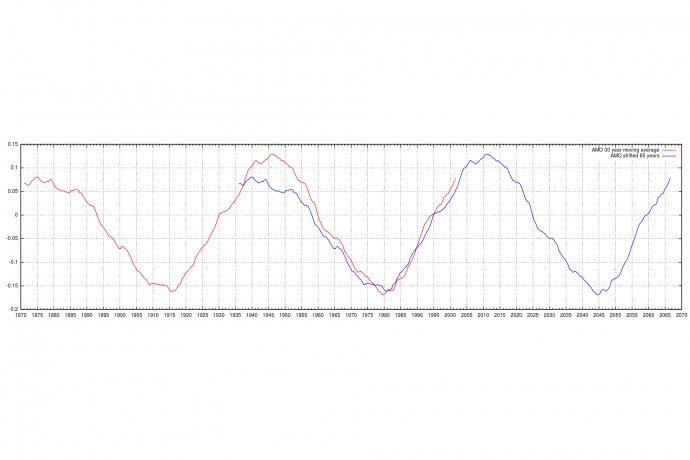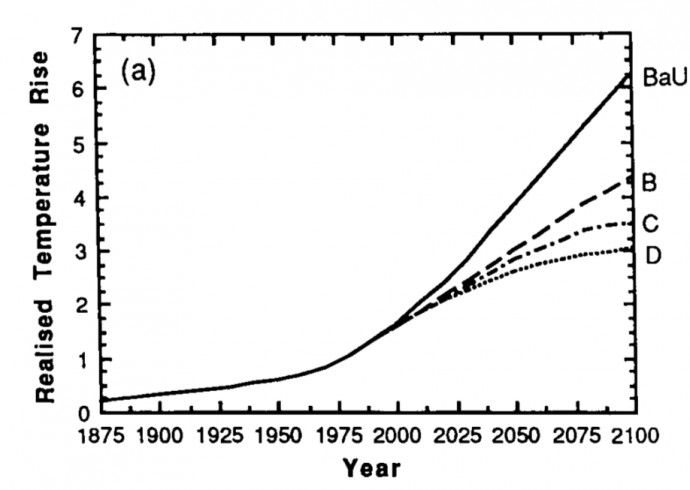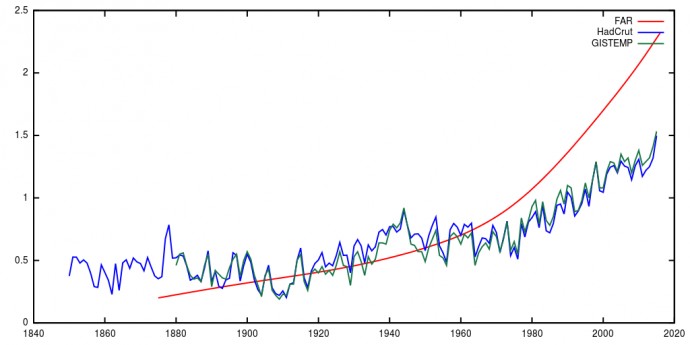|
General Global Warming / Climate Change Discussion
|
|
| midtskogen | Date: Monday, 24.11.2014, 10:58 | Message # 136 |
 Star Engineer
Group: Users
 Norway
Norway
Messages: 1674
Status: Offline
| Quote Watsisname (  ) Thus, your data and analysis are unsuitable for determining the cloud feedback
The observations and analysis didn't match the results that we expected, thus they are unsuitable? There must be an explanation for it that isn't too ad hoc, or we must admit that we don't know.
Quote Watsisname (  ) The feedback is a radiative forcing – change in flux balance between surface, cloud, and top of atmosphere. This is measured directly by satellite and further insight is gained via modelling.
Yes, clouds seen from the ground are only one piece of the complete picture, but the records go back long enough to compare trends with natural variability like the AMO. Satellites give a much more complete picture and we can examine effects of different weather configurations, but without the history. You can model the past based on what we know from the satellites and our understanding of global warming, but you can't apply that back to your model as a confirmation of it.
We were discussing Arctic cloudiness, in particular your assertion that global warming has decreased winter cloudiness, one piece to the story that Arctic clouds act as a negative feedback.
Quote Watsisname (  ) Any luck with the Journal of Geophysics: Atmospheres?
Well, everything seems to be paywalled. A search for "Arctic clouds" gave this as the second hit: Influence of Arctic sea ice extent on polar cloud fraction and vertical structure and implications for regional climate
But it seems to confirm my intuitive understanding. That a reduction of ice increases cloudiness, in particular low clouds. Which in winter time means warming of the surface, leading to less ice, leading to more clouds, warming, etc. The effects during the winter matter most since ice extent depend much on the ice production during winter and somewhat less on ice melt during summer (when the temperatures are relatively unaffected by warming).
Are you going to say that the problem with this study is that it uses observations and unsuitable analysis? You seem to prefer studies based on modelling with little direct observation potentially getting in the way of the results.
My hunch is that the "death spiral" is rather due to increased winter temperatures than to supposedly decreased albedo.Added (24.11.2014, 09:58)
---------------------------------------------
Interesting article: What It Would Really Take to Reverse Climate Change
Their findings do not seem very surprising and hopefully this could be a wake up call to others (who do interesting stuff, but with little or no effect on the problem they're thinking they're fixing), but it's pretty amazing that nuclear power is such a taboo and is not even mentioned in this article.
NIL DIFFICILE VOLENTI

Edited by midtskogen - Sunday, 16.02.2014, 18:01 |
| |
| |
| sandratharrismail | Date: Monday, 18.04.2016, 08:31 | Message # 137 |
|
Observer
Group: Newbies
 Pirate
Pirate
Messages: 1
Status: Offline
| http://bigessaywriter.com/blog....tioning climate changes grow rapidly. We all hear about global warming and greenhouse effect but far from everyone realizes what it means and how to deal with it, what impact it has on the planet we live in. Read the post above and these issues will become clear to you, these and many more.
|
| |
| |
| midtskogen | Date: Monday, 18.04.2016, 08:32 | Message # 138 |
 Star Engineer
Group: Users
 Norway
Norway
Messages: 1674
Status: Offline
| It's been some years since I've updated my climatological AMO average. How long until it's dipping again?

Looks like we should be back to 1995 levels again in 10 years or so. I'd like to see how satellite based temperature records turn out around 2030 before assessing a long term warming trend. It's unfortunate that the beginning of the satellite records coincides with the AMO bottom in 1979, in case multidecadal ocean circulations, of which AMO is a part, do make up more than a small dent.
NIL DIFFICILE VOLENTI

Edited by midtskogen - Friday, 19.08.2016, 06:47 |
| |
| |
| Watsisname | Date: Monday, 18.04.2016, 08:32 | Message # 139 |
 Galaxy Architect
Group: Global Moderators
 United States
United States
Messages: 2613
Status: Offline
| AMO is one of many oscillations that affect the climate and the global temperature, and we may expect a brief respite from the warming when it goes back to a negative phase. But it is not the main control knob. Global temperature does not follow it. Uncertainties in future warming due to the effect of AMO are small compared to uncertainties in future warming due to what humanity chooses to do. Which means we should be concerned about what humanity chooses to do.
Greenhouse gases, and especially CO2, are the biggest control knobs for Earth's climate. We know this because it explains not just the current warming but essentially all of Earth's climate history, and physics explains why. And we have more than a satellite record to test this with. 

|
| |
| |
| midtskogen | Date: Monday, 18.04.2016, 08:32 | Message # 140 |
 Star Engineer
Group: Users
 Norway
Norway
Messages: 1674
Status: Offline
| Quote Watsisname (  ) AMO is one of many oscillations that affect the climate and the global temperature, and we may expect a brief respite from the warming when it goes back to a negative phase. But it is not the main control knob. Global temperature does not follow it.
To me AMO seems to influence the Atlantic Arctic the most: It was very cold in Svalbard in the 1910's, very warm 1930-1950, very cold in the 1970's and very warm in 2000-2020?. It's interesting that whether typical winter temperatures are around -20C or -5C seems highly correlated with this graph. That said, a change in one area affects another. For instance a temperature change in the Fram straight will affect the flow of ice out of the entire Arctic ocean. The global impact is complex, AMO being only one oscillations of many, but the many oscillations interact. We need decades of further observations.
Quote Watsisname (  ) Greenhouse gases, and especially CO2, are the biggest control knobs for Earth's climate.
I don't think "control knobs" are a good allegory. Everything is connected, and a control board whose knobs make all the other knobs turn as well, wouldn't give you much control.
The "master knob" is of course the sun, but its output is nearly constant.
NIL DIFFICILE VOLENTI

|
| |
| |
| Watsisname | Date: Monday, 18.04.2016, 08:32 | Message # 141 |
 Galaxy Architect
Group: Global Moderators
 United States
United States
Messages: 2613
Status: Offline
| AMO is definitely a big factor up there. It's also important to precipitation patterns around the world. But it and whatever interactions occur with other parts of the system do not explain the Earth's climate history or where we are headed. If it was that important, then internal variability would be more important in the climate record than CO2. The reality is the opposite.
Quote midtskogen (  )
The "master knob" is of course the sun, but its output is nearly constant.
The Sun provides the energy in. Greenhouse gases control the balance of energy in and energy out. The sun does vary, by as much as 30% over Earth's history. Which is actually pretty big -- a 30% dimmer sun would freeze the whole Earth. Fortunately for life on Earth, when the Sun varies quickly, the changes are small. When the changes are big, they're slow, and the rock weathering thermostat beats them.
I do suggest seeing the presentation in the second link -- it is an outstanding review of the data and our understanding behind these ideas.

|
| |
| |
| midtskogen | Date: Monday, 18.04.2016, 08:32 | Message # 142 |
 Star Engineer
Group: Users
 Norway
Norway
Messages: 1674
Status: Offline
| The presentation leaves a few gaping questions. It didn't explain how exactly changes over geological time, i.e. thousands and millions of years, can predict changes within decades which is the timescale we're most interested in. We don't care that much what the temperature will be in half a million years if we keep CO2 at a certain level. In particular we want to know at what rates and magnitude temperature will change. We can't go back in the record and find an example where CO2 was doubled from 280 ppm within a century from an external source when the temperature was 14C. It's not that simple. People tend to look at geological evidence but still think in terms of a human lifespan. For instance, "an asteroid killed the dinosaurs". Right, but did they die within a few years or over several 100,000 years? That's a huge difference, and popular belief tend to favour something close to the former, though the geological record can't support it.
We have data from the ice ages with better temporal resolution. Ice ages end in spectacular ways by throwing the climate into a much more volatile state. The temperature rises sharply in a few decades. Not once, but several times after drops. Orbital changes lead to warming and an initial CO2 increase, and CO2 feedback can explain the rapid rise. Orbital changes are slow. But what explains the extreme volatility observed? And why doesn't temperatures rise so fast today when CO2 rises much more? Well, the initial CO2 level during ice ages is different, for one thing. Temperature too. And ice cover. Etc. So, yeah, we know that CO2 influences temperature and in what direction, but the rates, amplitudes and timelines are sort of sketchy. To the aid come observations over many decades.
NIL DIFFICILE VOLENTI

Edited by midtskogen - Friday, 19.08.2016, 19:47 |
| |
| |
| Watsisname | Date: Friday, 19.08.2016, 23:36 | Message # 143 |
 Galaxy Architect
Group: Global Moderators
 United States
United States
Messages: 2613
Status: Offline
| Quote midtskogen (  ) It didn't explain how exactly changes over geological time, i.e. thousands and millions of years, can predict changes within decades which is the timescale we're most interested in.
The geologic record shows us that the same greenhouse gas which is important for predicting current change is also important to understanding other changes throughout Earth history. That even with a large number of mechanisms for change in the Earth system across many different timescales, it's the radiative effect of CO2 which ends up being important in many of them.
How do we understand CO2's radiative effect? With physics. Physics we've understood for more than a century.
The Sun's luminosity increases over billions of years. On this timescale the amount of CO2 is controlled by the rock weathering thermostat which keeps the Earth's temperature fairly constant despite the large change in insolation.
Plate tectonics can change the distribution of ice and snow on the planet which change the albedo which can lead to snowball Earths. Then the slow steady accumulation of CO2 in the atmosphere via volcanoes over millions of years breaks the Earth out of them.
Periodic changes in Earth's orbit and obliquity change the distribution of sunlight across the Earth which in turn change the temperature and the amount of CO2. The CO2 then further changes the temperature and globalizes the record despite the changes in insolation not being uniform -- "half the world ignored its own sunshine, because the CO2 was more important for determining its temperature than the sunshine".
The PETM, a period of history I am very fascinated in because it is recorded right here in the rocks where I live, was triggered by a huge release of organic CO2 in the atmosphere. It increased the global temperature by many degrees C and changed ecosystems everywhere.
We cannot make sense of much of Earth history without understanding the radiative effect of greenhouse gases. The same understanding is important for predicting where we are headed. This is the lesson of the presentation.
Quote midtskogen (  ) Orbital changes are slow. But what explains the extreme volatility observed?
Since there are no external forcings with that much amplitude on that short a timescale, they must be internal changes. Rapid regional climate shifts must be an inherent process during the transition from ice age to interglacial. CO2's role in this process is to further drive the temperature and make the global temperature record more homogenized.
It's also important to note what data you use. If you are using a single ice core location, you cannot distinguish regional from global change. Does the whole Earth change that rapidly in unison?
Quote midtskogen (  ) And why doesn't temperatures rise so fast today when CO2 rises much more?
Inertia. It takes a long time to melt the cryosphere and warm the deep ocean. Even so, we're looking at +4C or more by 2100 with the amount of CO2 we're putting out. Which is fast. This is like going to the PETM many times faster than the PETM unfolded.

|
| |
| |
| midtskogen | Date: Saturday, 20.08.2016, 06:55 | Message # 144 |
 Star Engineer
Group: Users
 Norway
Norway
Messages: 1674
Status: Offline
| It's a neat explanation for how the Earth have avoided runaway climate changes over millions and millions of years, but what is questioned is the explanatory power of large scale mechanisms for small scale phenomena even though the driver is shared.
Quote Watsisname (  ) Does the whole Earth change that rapidly in unison?
I think Greenland is more volatile and Antarctica, and for the rest we have less reliable data? But even localised volatility needs to be understood when it's different now and then.
Quote Watsisname (  ) Inertia.
I would expect the inertia not to have changed much over the past 10.000 years. The internal changes may be different because the situations are somewhat different, but if internal changes can account for so much, then it makes projections in a unprecedented situation kind of difficult.
Quote Watsisname (  ) we're looking at +4C or more by 2100
We need 0.4C per decade for that, but it's not what we're observing, and the longer it goes without such warming, the more likely it is that this projection is wrong, or if we actually hit >4C in a late dash, that the projection was right but for the wrong reasons. In either case a lot of scientific papers must be thrown into the bin. We observe something closer to 0.1C/decade (over the past 70 years), which barely takes us to +2C by 2100 unless internal variability dominates.
NIL DIFFICILE VOLENTI

|
| |
| |
| Watsisname | Date: Saturday, 20.08.2016, 15:19 | Message # 145 |
 Galaxy Architect
Group: Global Moderators
 United States
United States
Messages: 2613
Status: Offline
| It is very neat -- the rock weathering thermostat in particular is an amazing thing and it's interesting to speculate what it may do on other planets. It's one reason among many for the rethinking of the original "Habitable Zone" concept.
I'm not entirely clear on what you mean with connecting large and small scale. Physics connects the radiative forcing of greenhouse gases to Earth's energy balance. To connect that with what happened locally requires understanding what happens within the Earth system. That's where geology comes in -- using the geologic evidence to determine the context of what happened, where it happened, and when it happened.
Turns out that in understanding why it happened, the radiative effect is often more important than we might have expected. The predictive and explanatory power is very strong here. And the same is true today. We observe that the CO2 is reducing the radiative efficiency of the planet (we can directly measure this with spectroscopy), and there is no other successful explanation for what the climate is currently doing than this. And a lot of people have tried proposing a lot of other explanations. 
Quote midtskogen (  )
I think Greenland is more volatile than Antarctica
Yes, Greenland tends to change faster. Antarctica is bigger, thicker, and surrounded by vaster ocean.
The notable early spike in GISP2 record, followed by sudden drop back to ice-age temperatures, and final warming back up to the interglacial with Vostok, is a consequence of the sudden intrusion of melt-water into the oceans from lakes which had been locked behind the ice dams. This in turn shut down the overturning circulation, which had a huge effect on northern hemisphere climate, basically bringing it briefly back into the ice age conditions. This is sudden, internally-forced climate change. (It also motivated the story of the "Day After Tomorrow", however unrealistic that film is in portraying it.)
This is also why I say to be careful when examining the rapidity of global change from individual datasets. You were looking at the extreme volatility seen, wondering how that arises from the smooth transitions in orbit-obliquity forcing. The answer is the internal dynamics.
Quote midtskogen (  ) I would expect the inertia not to have changed much over the past 10.000 years.
Indeed. Oceans are still the same mass with about the same circulation cycle. If anything, inertia is less now because there is less ice. But remember the above caution, and remember the different mechanisms in play.
Quote midtskogen (  ) We need 0.4C per decade for that, but it's not what we're observing, and the longer it goes without such warming, the more likely it is that this projection is wrong,
Each year, there is more CO2 in the atmosphere. The equilibrium temperature increases, and if it increases faster than the rate you move towards it, the rate you move towards it increases too. Now add accelerating emissions. Most of the warming occurs later this century. This is simple differential equations.
What is currently happening is in line with the models (and the latest have already accounted for the slowdown last decade), and under high emissions we are still headed for over 4C of warming by 2100. This is A1F1 scenario: assumes we remain fossil fuel intensive and utilize reserves we know exist and are economically viable to extract. Hopefully this scenario is wrong. It predicts more than twice the warming threshold set by scientific and international agreement.

Added: For completeness, these are warming thresholds for other scenarios -- the RCP scenarios, or "representative concentration pathways". Each is a different take on what humanity might do. The RCP number represents the radiative forcing value in the year 2100.

This is to emphasize what I said earlier -- uncertainty in what happens in the future is mostly due to uncertainty in what we choose to do. In other words, what we choose to do is important. Just like rock weathering beats the Sun's evolution, humanity's emissions beats natural variability. Except perhaps a few km size meteor impact or supervolcano. And I really hope we don't have either of those. 

|
| |
| |
| midtskogen | Date: Saturday, 20.08.2016, 20:43 | Message # 146 |
 Star Engineer
Group: Users
 Norway
Norway
Messages: 1674
Status: Offline
| Quote Watsisname (  ) I'm not entirely clear on what you mean with connecting large and small scale.
Timescales. Geology tells us about the big picture when something changes. We're now mostly concerned about the short term effects. For instance, inertia clearly plays a role for the short term.
Quote Watsisname (  ) What is currently happening is in line with the models (and the latest have already accounted for the slowdown last decade)
And accounted means post hoc fitting? Let's check the first assessment report. It looks like this:

And compared to observations using the business as usual scenario (reality in 2016 arguably looks most like the 1990 IPPC scenario BaU):

Now, a great deal can be said about the level matching. I've attempted to line up the model with observations up to 1990. If you instead match the model with the dip in 1989 and replace model prior to that with observations, it might not look that bad and the only thing standing out is "the Pause".
It's will be very interesting to see what happens next. Does the latest peak mark the beginning of a trend catching up with the projections? Or will it simply level out at a higher level? Or will it just be an El Niño artifact? Do you see why I think 15 more years or so of observations will be important and worth the wait scientifically? It will also shed some light on whether the relatively sharp rises from 1920 to 1940 and from 1980 to 2000 have a link to AMO. That is, has "the Pause" something to do with an accellerated warming prior to the Pause due to multidecadal oscillations?
Quote Watsisname (  ) and under high emissions we are still headed for over 4C of warming by 2100.
It might be more useful to speak of ECS than 2100 temperature. AR5 says that ECS is likely between 1.5 and 4.5C. That's a pretty wide range, bordering to we don't really know! And that's when the time it takes to reach equilibrium is taken out of the equation. 100 years, or 1000 years? This makes it hard to project the temperature for a certain year even if you know what the emissions will be.
NIL DIFFICILE VOLENTI

Edited by midtskogen - Saturday, 20.08.2016, 21:19 |
| |
| |
| Watsisname | Date: Sunday, 21.08.2016, 04:52 | Message # 147 |
 Galaxy Architect
Group: Global Moderators
 United States
United States
Messages: 2613
Status: Offline
| Quote midtskogen (  ) Timescales. Geology tells us about the big picture when something changes. We're now mostly concerned about the short term effects. For instance, inertia clearly plays a role for the short term.
Geology tells us the global and local context of change on a wide range of scales. Volcanoes and meteor impacts give good indication of how changes in the radiation balance affect the climate on very short timescales, where inertia is important.
Quote midtskogen (  ) It might be more useful to speak of ECS than 2100 temperature. AR5 says that ECS is likely between 1.5 and 4.5C.
If ECS is 1.5, then under emissions scenarios reaching ~1000ppm, the temperature increase is about 3C. More than the 2C set by international agreement. If ECS is 4.5, then the same emissions scenario results in about 9C of warming. That's twice the difference between an ice age and today.
So, uncertainty in what happens due to ECS is of similar magnitude to uncertainty due to what humanity chooses to do. Which does make it very important. But if ECS is low, it's still more warming than we want, and if its high, we're in even bigger trouble. 9C temperature rise on timescales of centuries would cause mass extinction and change ecosystems everywhere. Future geologists would see a layer in the rocks demarcating the end of the Cenozoic and wonder "what the heck happened there?"
I'm all for getting new data to extend the satellite record over more than 1 AMO cycle. I will always say yes to more data for hypothesis and robustness checking. I will always say yes to bettering our understanding of natural variability. But we already have billions of years of data with which to understand what changing radiative forcing did for the climate under a wide range of mechanisms, and we have the physics to understand that connection. Does AMO have any effect? Of course. But AMO is a subset of natural variability and natural variability is small compared to the change in radiative forcing we are causing. If humanity chooses to wait to see what happens every time there's a short-order fluctuation in the temperature, we end up facing large temperature rise and potentially infeasible methods of avoiding it.

|
| |
| |
| midtskogen | Date: Sunday, 21.08.2016, 07:07 | Message # 148 |
 Star Engineer
Group: Users
 Norway
Norway
Messages: 1674
Status: Offline
| Quote Watsisname (  ) Volcanoes and meteor impacts give good indication of how changes in the radiation balance affect the climate on very short timescales
For the asteroid impact, the evidence from geology will be a global iridium rich layer, including things like glass spherules, and around the impact site further evidence of rocks that must have formed under impact conditions. Also evidence of soot from fires. And perhaps evidence of tsunamis. But I think much of the short time effects must be inferred, like for how many years was the climate affected and how much. I don't see how that can be read directly from the rocks.
Quote Watsisname (  ) But if ECS is low, it's still more warming than we want, and if its high, we're in even bigger trouble. 9C temperature rise on timescales of centuries would cause mass extinction and change ecosystems everywhere. Future geologists would see a layer in the rocks demarcating the end of the Cenozoic and wonder "what the heck happened there?"
We're already seeing a rate of extinction likely much higher than ordinary evolution would normally produce, but it's mostly for different reasons. 0.8C change in 100+ years is a blip (I utterly reject the shaft of the hockey stick) not having been able alone to do much globally. In my opinion this is extremely important to realise. For my entire life I've loved to be out in nature, so I care much personally. There are many things about our influence on the environment that I'm concerned about, and focus is drawn away from them because of worries about the temperature. The ecosystems are used to temperature changes. Not meaning that everything will be static. Evolution needs change and life needs evolution. Overall life will be just fine. It would thrive with smaller icecaps. But we're likely not going that way anyway. I'm a technology optimist, and I don't think the main source of energy for humans will be the stone-age technology of burning fossil fuel. I'm slightly worried, though, by the factions of environmentalists who go against nuclear power and prosperity growth, and aim to make energy more unaffordable. I think they're dangerously wrong. The key to a better world, both for humans and the environment, is cheap and easily available energy. Fossil fuel can never be that cheap. With cheap energy and prosperity growth we can combat poverty, a prerequisite for stopping population growth, which is the break needed to let environmental sustainability catch up. The solution is at hand and talk about the weather should not distract.
NIL DIFFICILE VOLENTI

Edited by midtskogen - Sunday, 21.08.2016, 07:14 |
| |
| |
| steeljaw354 | Date: Sunday, 21.08.2016, 16:10 | Message # 149 |
 World Builder
Group: Users
 Pirate
Pirate
Messages: 862
Status: Offline
| What can we do stop Global warming/ climate change?
|
| |
| |
| spacer | Date: Sunday, 21.08.2016, 17:43 | Message # 150 |
 Star Engineer
Group: Users
 Israel
Israel
Messages: 1258
Status: Offline
| steeljaw354, the problem is that we cant stop it. i think we crossed the red line.
we can only reduce it, not stop it.
we can move to green energy. sun/wind/water.
maybe the only way to stop it will be if someday suddenly alll world shut down every no clean energy site, ban cars, or anything like that
"we began as wanderers, and we are wanderers still"
-carl sagan
-space engine photographer
|
| |
| |